ಬದಾಮಿ ಗುಹಾಂತರ ಗುಡಿ
Badami Cave Temple
Useful Information
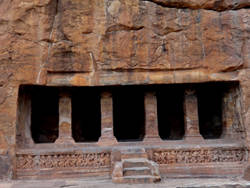
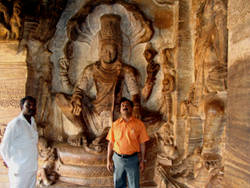
| Location: |
Badami, Bagalkot District – 587201, Karnataka.
About 120 km from Bijapur, 46 km from Aihole. (15.918333, 75.684167) |
| Open: |
All year daily 9-17:30. [2023] |
| Fee: |
Adults INR 100, Indians INR 5. [2023] |
| Classification: |
 Cave Church
in sandstone Cave Church
in sandstone
|
| Light: | bring torch |
| Dimension: | |
| Guided tours: | self guided |
| Photography: | allowed |
| Accessibility: | no |
| Bibliography: | |
| Address: | Badami Cave Temple, Badami, Bagalkot District – 587201, Karnataka. |
| As far as we know this information was accurate when it was published (see years in brackets), but may have changed since then. Please check rates and details directly with the companies in question if you need more recent info. |
|
History
Description
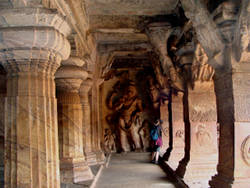
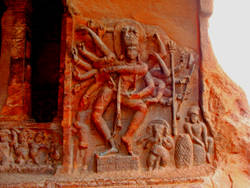
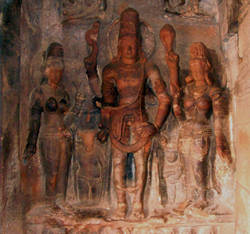
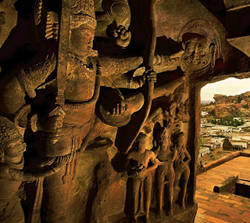
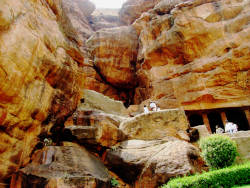
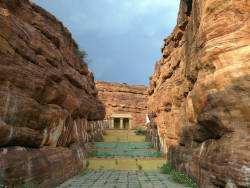
Badami is the Capital of the early Chalukya Empire. There are four rock-cut cave temples in the sandstone cliffs above the town, on the right side of a valley with an artificial lake. The valley contains numerous temples dedicated to Vishnu and Shiva. Most important are the Bhutanath temples that derived their name from the lake. The temples are known as ಬದಾಮಿ ಗುಹಾಂತರ ಗುಡಿ (Badami Cave Temples), but also as Chalukyan Caves.
- The lowest temple dates back to 578 A.D.. On the upper end of a wry 40 steps staircase, the cave has a colonnaded veranda with many reliefs. Behind the columns lies a hall with numerous pillars and a square shaped sanctum. There are paintings of amorous couples, Shiva and his consort Parvati, a coiled serpent, and the 18-armed lord Nataraja in 81 dancing poses.
- Some stairs up is the second temple, dedicated to Vishnu. A dwarf or Trivikrama of awesome dimensions with one foot mastering the Earth and the other the sky, is a form of lord Vishnu. Another form of Vishnu portrayed here is a boar called Varaha. And finally there is a frieze depicting Vishnu as Lord Krishna.
- The third temple is the largest one, also dedicated to Vishnu. It is from the 6th century, and its reliefs give an insight into the art and culture of this time, showing costumes, jewelry, and hairstyle. Other reliefs depict Vishnu with a serpent, Vishnu as Narasimha (lionman) Varaha, Harihara (Shiva Vishnu) and Vishnu as Trivikrama. The front is 21 m wide.
- Finally there is Jain Cave, the youngest of the four temples, completed about 100 years later. The encarvings show Tirthankara Parshavnatha with a serpent at his feet and Mahavira in a sitting posture.
Overlooking the Bhutenatha lake or Agarthya lake, where the mossy green water is considered to cure illness, are the Chaluky Caves. There are five caves, four are artificial and one natural, and they are all connected by flights of steps. The Chalukyans were tolerant of all sects and elements of Shaivism, Vaishnavism, Jainism and Buddhism can be found in the caves.
Cave No 1: One can easily climb to Cave No 1 which is thought to be pre-578 AD and was probably the first to be carved. Climbing the 40 steps one reaches the colonnaded veranda, a hall with numerous pillars and a square shaped sanctum hollowed out in the rear wall. Columns are masterfully crafted and on the ceiling one can see the paintings of amorous couples including Shiva and his consort Parvati, together with a coiled serpent God. The veranda also has a frieze of ganas or comic looking attendants. Shiva as Natraja with 18 arms is seen in 81 dancing poses.
Cave No 2: Going up the sandstone hill one comes across Cave No 2 which is dedicated to Vishnu who is depicted as a dwarf or Trivikrama of awesome dimensions with one foot mastering the Earth and the other the sky. Another form of Vishnu portrayed here is as Varaha or a boar. A frieze endearingly depicts Vishnu as Lord Krishna, Vishnu riding the Garnda, and a lotus surrounded by sixteen fishes.
Cave No 3: This is further on up the hill and is thought to date from 578 AD. The facade of the cave is nearly 21 m wide, and on the plinth one can see the carvings of ganas. The sheer artistry and sculptural genius makes it this cave the highlight of Deccani art. It gives a virtual insight into the art and culture of the 6th century showing costumes, jewellery, hairstyle etc. The other attractions in this cave are the high relief of Vishnu with a serpent, Vishnu as Narasimha (Vishnu as Man-Lion) Varaha, Harihara (Shiva Vishnu) and Vishnu as Trivikrama.
Cave No 4 was first started in the 6th century and completed nearly 100 years later than the earlier three caves. This is the lone Jain cave. Here one can see the carvings of the Tirthankara Parshavnatha with a serpent at his feet; Mahavira in a sitting posture also can be seen in the shrine. It also has a statue of Parshuanatha with two dvarapals or doorkeepers. At the entrance, steps from these caves lead to the south fort.
Text by Tony Oldham (2003). With kind permission.
 Search DuckDuckGo for "Badami Cave Temple"
Search DuckDuckGo for "Badami Cave Temple" Google Earth Placemark
Google Earth Placemark Badami cave temples - Wikipedia (visited: 07-JUL-2020)
Badami cave temples - Wikipedia (visited: 07-JUL-2020) Badami Cave Temple
Badami Cave Temple Index
Index Topics
Topics Hierarchical
Hierarchical Countries
Countries Maps
Maps